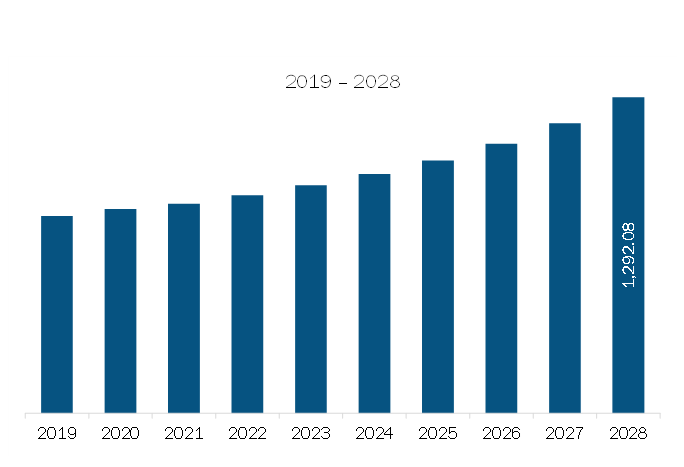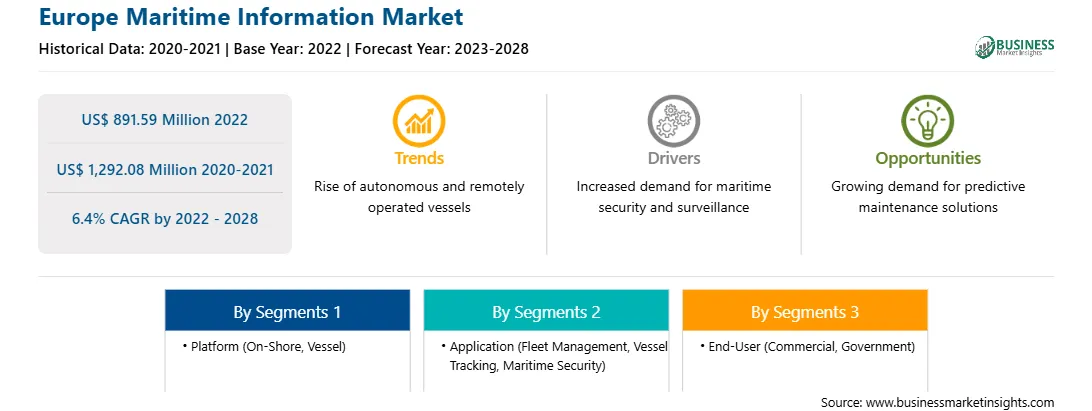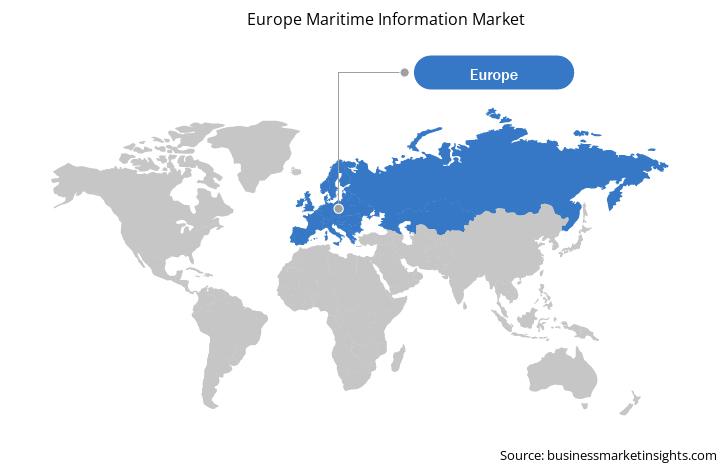Need for Efficient Management of Complex Supply Chain Operations is Driving the Europe Maritime Information Market
The marine industry is embracing digitalization in a bid to improve efficiency, build smarter ships and fleets, and attain readiness toward regional trade expansion. Supply networks are expanding and growing more complex with a rise in consumer demand. Marine businesses need to continuously work out and implement new strategies to maximize efficiencies and streamline supply chains in the fiercely competitive marketplace. The integration of innovative technologies such as AI, blockchain, IoT, and automation into maritime operations enables the easy arrangement of inventory data, tracking and management of ships, tracking of information, and generation of electronic invoices. Using these technologies, shipping businesses can reduce the amount of time spent shipping, receiving, tracking, and gathering order data. These technologies aid in streamlining existing procedures, developing fresh commercial prospects, and transforming supply networks. End users can successfully manage supply chain activities by leveraging design and simulation tools, warehouse management, transportation and yard management, and end-to-end logistics network control aided by maritime information. Additionally, stricter environmental regulations continue to influence the maritime transportation industry since transporters must save costs and ensure sustainability in operations. Thus, the increasing need to efficiently manage complex supply chain operations drives the demand for maritime information systems.
Europe Maritime Information Market Overview
Germany, the UK, Russia, and the Rest of Europe are the key contributors to the maritime information market in the Europe. The European marine industry is driven by the recent development of frigates and offshore patrol boats, owing to their lethality, speed, and maneuverability. Furthermore, incidents such as an increase in illegal immigrant intrusions and drug trafficking in countries such as Italy, Spain, and Albania, have increased the demand for maritime information across the region. Additionally, maritime information has gained importance in the European region due to the growth of maritime trade and rapid globalization. The industry is also witnessing advances in technology that enable real-time data transmission. Furthermore, the European maritime information market is mainly driven by the growth of trade and tourism, where advanced Vessel traffic services (VTS) technology services are required to ensure optimal safe operation. In addition, the growing demand for advanced maritime security systems in countries such as Germany, the UK, France, and Italy is also driving the market. Commercial and government sectors widely use maritime intelligence to identify vessels, assist coast guards in search missions, curb human trafficking, and gather data about operations. In addition, maritime information systems analyze and manage various hazardous events, such as earthquakes in the ocean. Hence, increasing marine threats and rising demand for channel intelligence are expected to propel market growth. Several software companies are collaborating with leading shipping companies to offer end-to-end marine solutions, which is fueling the market growth. For instance, in April 2022, the internet of Things (IoT) solutions provider ORBCOMM Inc. collaborated with Hapag-Lloyd, a German-based shipping company, to offer ORBCOMM's latest telecommunications technology end-to-end visibility to its massive dry container fleet. Hapag-Lloyd is the first in the industry to use ORBCOMM's purpose-built dry bin IoT technology to increase efficiency. ORBCOMM's dry container telecommunications solution meets Hapag-Lloyd's requirements for anti-future technology, enabling compliance with certified marine industry safety standards.

Strategic insights for the Europe Maritime Information provides data-driven analysis of the industry landscape, including current trends, key players, and regional nuances. These insights offer actionable recommendations, enabling readers to differentiate themselves from competitors by identifying untapped segments or developing unique value propositions. Leveraging data analytics, these insights help industry players anticipate the market shifts, whether investors, manufacturers, or other stakeholders. A future-oriented perspective is essential, helping stakeholders anticipate market shifts and position themselves for long-term success in this dynamic region. Ultimately, effective strategic insights empower readers to make informed decisions that drive profitability and achieve their business objectives within the market.

| Report Attribute | Details |
|---|---|
| Market size in 2022 | US$ 891.59 Million |
| Market Size by 2028 | US$ 1,292.08 Million |
| CAGR (2022 - 2028) | 6.4% |
| Historical Data | 2020-2021 |
| Forecast period | 2023-2028 |
| Segments Covered |
By Platform
|
| Regions and Countries Covered | Europe
|
| Market leaders and key company profiles |
|
The geographic scope of the Europe Maritime Information refers to the specific areas in which a business operates and competes. Understanding local distinctions, such as diverse consumer preferences (e.g., demand for specific plug types or battery backup durations), varying economic conditions, and regulatory environments, is crucial for tailoring strategies to specific markets. Businesses can expand their reach by identifying underserved areas or adapting their offerings to meet local demands. A clear market focus allows for more effective resource allocation, targeted marketing campaigns, and better positioning against local competitors, ultimately driving growth in those targeted areas.

Europe Maritime Information Market Segmentation
The Europe maritime information market is segmented into platform, application, end-user, and country.
Based on platform, the Europe maritime information market is bifurcated into on-shore and vessel. In 2022, the vessel segment registered the larger share in the Europe maritime information market.
Based on application, the Europe maritime information market is segmented into fleet management, vessel tracking, and maritime security. In 2022, the fleet management segment registered the largest share in the Europe maritime information market.
Based on end-user, the Europe maritime information market is segmented into commercial and government. In 2022, the commercial segment registered the larger share in the Europe maritime information market.
Based on country, the Europe maritime information market is segmented into Germany, France, Italy, the UK, Russia, and the Rest of Europe. In 2022, the Rest of Europe segment registered the largest share in the Europe maritime information market.
BAE Systems Plc; Fujitsu Limited; Iridium Communications Inc.; L3Harris Technologies Inc.; Lockheed Martin Corp; Northrop Grumman Corp; ONEOCEAN; ORBCOMM Inc.; Polestar; Saab AB; Siemens AG; Spire Global; Thales Group; and Windward Ltd are the leading companies operating in the Europe maritime information market.
The Europe Maritime Information Market is valued at US$ 891.59 Million in 2022, it is projected to reach US$ 1,292.08 Million by 2028.
As per our report Europe Maritime Information Market, the market size is valued at US$ 891.59 Million in 2022, projecting it to reach US$ 1,292.08 Million by 2028. This translates to a CAGR of approximately 6.4% during the forecast period.
The Europe Maritime Information Market report typically cover these key segments-
The historic period, base year, and forecast period can vary slightly depending on the specific market research report. However, for the Europe Maritime Information Market report:
The Europe Maritime Information Market is populated by several key players, each contributing to its growth and innovation. Some of the major players include:
The Europe Maritime Information Market report is valuable for diverse stakeholders, including:
Essentially, anyone involved in or considering involvement in the Europe Maritime Information Market value chain can benefit from the information contained in a comprehensive market report.